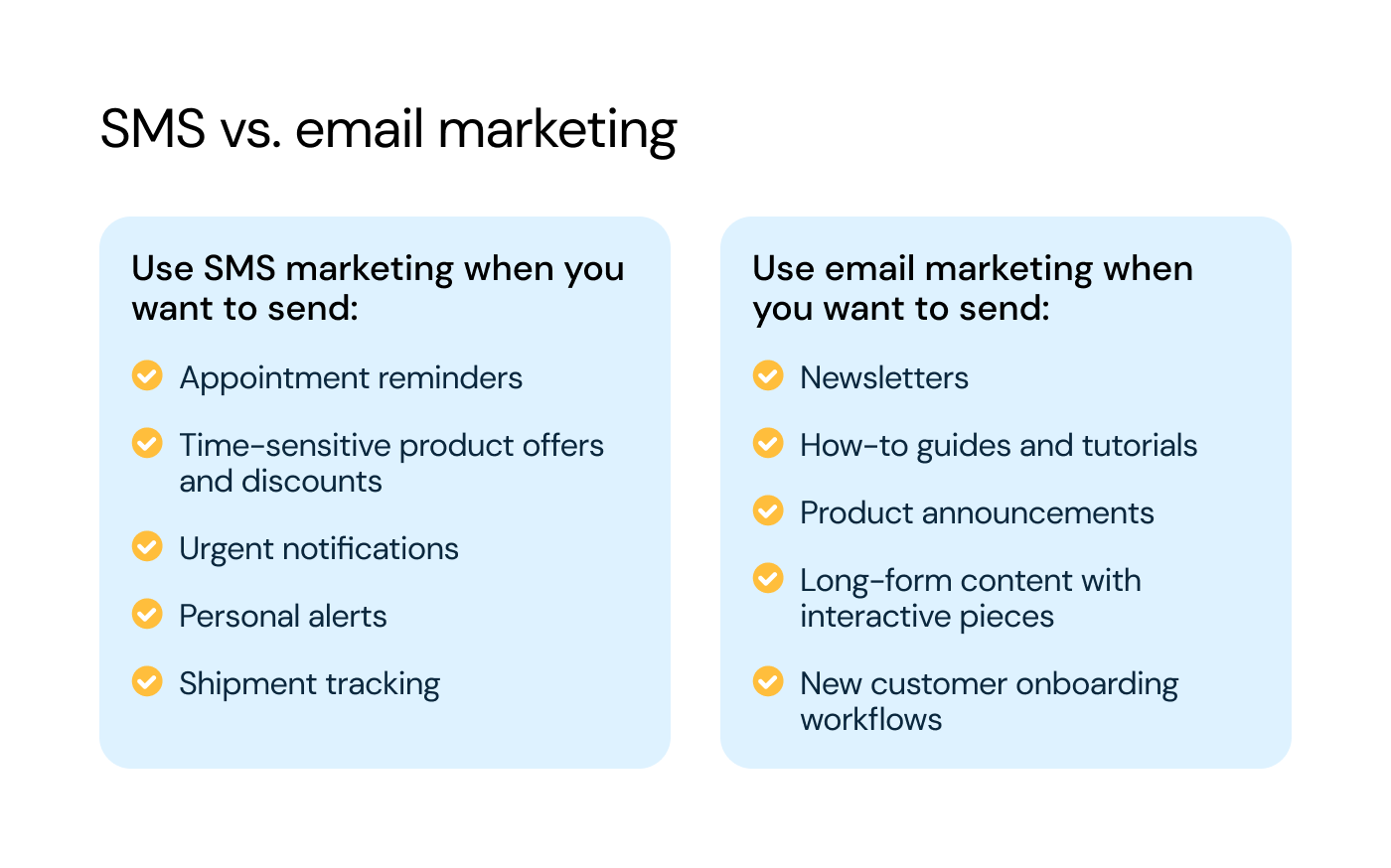Let’s set the stage: Your marketing team finds itself planning for the launch of a new product or service, and you’re eager to create buzz in the market. However, you’re constrained by a limited budget and need to strategically decide how to maximize your resources. A familiar question arises: Will SMS or email have the highest ROI?
It’s probably not that difficult to imagine because, for marketers, it’s a common scenario.
On one hand, SMS can deliver instant notifications to your audience – it’s direct, immediate, and perfect for sending time-sensitive information.
On the other hand, email offers broader distribution and the opportunity to include visuals and in-depth information. It’s versatile and ideal for building relationships with your customers.
As marketers seek to maximize their impact, this dilemma frequently comes up: SMS vs email – which channel will have the best results? Let’s dive into these two channels to determine the best fit for your marketing strategy.
What’s the difference between email and SMS?
When it comes to SMS vs email, there’s a lot to consider.
Since the first text message was sent in 1992, Short Message Service (SMS) has remained largely the same – short (160 characters) and direct. This simplicity has driven its massive use and popularity, as SMS is supported by every mobile device in the world (to show just how massive SMS is, that’s 7.3 billion people!).
In contrast, email has changed significantly since its invention in the 1970s. From the shift from plain text to HTML emails, the incorporation of images and videos, the development of responsive design, and even the integration of CSS animations and interactive elements, email has evolved into a dynamic, engaging way to communicate. To top it off, an estimated 4 billion people use email, with this number growing every year.
Let’s take a look at how text message and email marketing measure up.
|
SMS |
|
|
|
Open rates |
98% |
Between 15-20% |
|
Click through rate (CTR) |
Around 20% |
3-5% |
|
Affordability |
Fairly cheap |
Cheap, especially for large volumes |
|
ROI |
High |
High |
|
Reliability |
Seldom goes to spam |
Susceptible to spam filters |
|
Reach |
Mobile phone users |
Accessible on various devices and platforms |
|
Response rates |
40-50% |
4-6% |
|
Character limit |
Limited to 160 characters |
No limit – can be short or long |
|
Capabilities |
Send written text only |
Send text, images, videos, forms, links, social media buttons, and so much more |
Pros and cons of SMS
SMS marketing holds a special place in the world of digital marketing because it feels personal and one-to-one. However, like any tool, SMS comes with its own set of pros and cons.
Here are some advantages of SMS marketing campaigns:
- High open and engagement rates: Text campaigns have an average open rate of 98%, and their concise nature encourages recipients to engage with content quickly.
- Immediacy: With text message marketing, recipients get notifications immediately, which means that SMS is ideal for sending exclusive offers.
- Conversational: SMS is a two-way conversational channel, meaning you can have one-to-one conversations with customers and easily answer their questions as they come in.
- Direct and personal: Text messages are often considered a personal channel to communicate, giving your brand the opportunity to create a close connection with your customers.
- Wide reach: According to Statista, there are more mobile phones in the world than people! That means you potentially have a huge swath of people available to communicate with using SMS.
- Ease of use: Text messages are sent via a cellular network and don’t require a data plan or internet connection to be delivered to a mobile phone, and users don’t have to download a third-party app or service to receive them.
Of course, there are also some disadvantages of SMS marketing. Unlike email, SMS messages don’t support images or multimedia content, and the character limit is restrictive when you want to convey detailed information. It’s important to note that because SMS messages are delivered instantly and demand immediate attention, your recipients might find them annoying or disruptive in certain situations if they’re used inappropriately or too frequently.
Pros and cons of email marketing
Email has become an integral part of our personal and professional lives. It offers great reach and cost effectiveness but is also susceptible to inbox clutter and spam filters. Let’s go through a few of the advantages and disadvantages of email marketing.
Here are some advantages of running an email marketing campaign:
- More words to get your point across: If you’re sharing detailed or extensive content, email is a great way to promote it. Compared to SMS, email doesn’t have many content limitations. That makes it great for things like newsletters and product updates.
- Opportunities to engage: Because you’re not limited by the number of links you can send, email allows subscribers to engage with embedded links, videos, and more.
- Easy to share and forward: People who love your brand can easily forward your updates and promotions to their friends and family.
- Interactive, personalized experiences: Email can help you provide interactive experiences with dynamic templates that include things like forms, product previews, and more.
- Less intrusive: Recipients don’t necessarily get a notification every time they receive an email message, which means they can read them at their convenience.
- Great ROI: On average, email drives a return on investment of $36 for every dollar spent, higher than any other channel.
- Email is checked frequently: 99% of email users check their inbox every day, with some checking it 20 times per day.
Of course, email marketing faces challenges like deliverability issues, where messages might end up in spam folders. Email marketers also face hurdles like oversaturation, where the sheer volume of emails competing for attention can lead to message fatigue. That’s why it’s important to make sure your email marketing campaigns are compelling, targeted, and adhere to best practices for deliverability.
SMS vs email: Should you use just one, or both?
At this point, we know what you’re thinking: Now I know the pros and cons of SMS and email marketing, but which one do I choose?
The answer isn't that simple – that’s why we recommend evaluating a few things as you put together your marketing strategy:
- The nature of your business: Consider your brand and your industry. Some businesses need to give instant updates, while others rely on nurturing long-term relationships. Is one more important than the other, or do both have a level of importance?
- Your target audience: Delve into your customers’ preferences and behaviors. Do they need to know something immediately, or would they prefer a more in-depth, visually appealing representation? Understanding your target audiences’ communication preferences and habits is key to tailoring your marketing strategy.
- What you want to convey: Do you need to send a limited-time offer, or are you sharing a content-rich product update? As a rule of thumb, email works better when the information you want to share isn’t time sensitive and SMS is better for things that need immediate attention.
Truth be told, email and text marketing have unique strengths in different scenarios, and the key to using both channels lies in having clear goals and objectives around what you want to accomplish and communicate. The best marketing strategies include both channels and take into account customer preferences, as they complement each other in what they can offer your customers.
Best practices for combining SMS and email
Now, you might be wondering: I read this entire blog, and the conclusion is that both tools are necessary? That’s not a straightforward choice between one or the other.
And that’s right. A well-planned omnichannel strategy will provide the most effective results, keeping your marketing budget in check and optimizing ROI.
Here are a few things to consider as you plan to use an omnichannel strategy to maximize the impact of your marketing efforts.
Start with an opt-in campaign
Regardless of the communication channels you use, you need to ensure that people have willingly opted in to be contacted by you. Email compliance standards have tightened over the past decade and SMS compliance is even more strict.
Above all, make sure that your email and SMS efforts comply with relevant regulations, like the Telephone Consumer Protection Act (TCPA) for SMS and laws like GDPR and CAN-SPAM for email. It’s critical for you to obtain proper consent from recipients and provide clear opt-out options before starting any marketing program.
Learn more about opt-in campaigns: Check out this resource about email opt-in campaigns or learn about SMS opt-in best practices.
Have a segmentation strategy
Both email and text message marketing have unique strengths for reaching your audience with different updates. That’s why it’s important to segment your audience. Segmentation could look like allowing users to choose how they want to receive shipping updates or purchase confirmations when they create an account, for example, and targeting them through the channel of their choice.
Segmentation avoids redundancy and maximizes the impact of each marketing channel. It ensures your messages are tailored to preferences and behaviors of your recipients while minimizing the risk of message fatigue. Effective segmentation lets you nurture stronger, more lasting relationships with your audience, resulting in higher impact and better ROI for your marketing efforts.
Learn more about email segmentation: Here's how email segmentation has a direct impact on your conversion rate.
Use the channels to complement each other
We’ll leave you here with the analogy of SMS and email being “siblings, not twins” in your marketing strategy. Think of email as being the eloquent sibling who narrates a story in detail including photos. SMS, meanwhile, is the snappy sibling that delivers immediate, punchy updates.
Together, they can help you create a cohesive omnichannel marketing strategy – each having a distinct style that's complementary to the other to captivate your audience.

SMS marketing is great for time-sensitive messages like appointment reminders and flash sales, while email marketing offers a way for sharing long-form content like newsletters and product updates.
Get started with SMS and email marketing
Let’s go back to the example we used at the beginning of this blog. You’re choosing the “right” channel for a new product launch with a limited marketing budget. You ask yourself, will email be the right choice? Or SMS?
There’s no clear winner here: Both SMS and email have their own place and purpose in a well-thought-out marketing strategy. For example, you could use email to send an overview of the new product and use SMS to offer a flash sale on that same product.
That’s why the answer is omnichannel marketing: A customer-centric approach that integrates marketing methods, so the customer has a unified, consistent experience via SMS, email, and other conversational channels. Omnichannel marketing helps companies build brand awareness, increase customer engagement, and deliver compelling communication experiences wherever they happen.
If your goal is a customer-centric strategy, reaching people on all the channels they use in their journey is a great place to start. Check out our guide on how to create an omnichannel customer journey, or take a deeper dive into our ultimate conversational messaging guide to get started.

Or, when you’re ready to talk about all things SMS and email, let’s chat. Our team is ready to help you build an omnichannel experience your customers will love.



